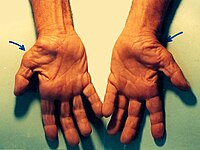
Photo from wikipedia
Background: Current classifications for cubital tunnel syndrome have not been shown to reliably predict postoperative outcomes. In this article, the authors introduce a new classification that incorporates clinical and electrodiagnostic… Click to show full abstract
Background: Current classifications for cubital tunnel syndrome have not been shown to reliably predict postoperative outcomes. In this article, the authors introduce a new classification that incorporates clinical and electrodiagnostic parameters, including compound muscle action potential amplitude, to classify the preoperative severity of cubital tunnel syndrome. The authors compare this to established classifications and evaluate its association with patient-rated improvement. Methods: The authors reviewed 44 patients who were treated surgically for cubital tunnel syndrome. Patients were retrospectively classified using their proposed classification and the Akahori, McGowan-Goldberg, Dellon, and Gu classifications. Correlation of grades was assessed by Spearman coefficients and agreement was assessed by weighted kappa coefficients. Patient-reported impairment was assessed using the Disabilities of the Arm, Shoulder, and Hand questionnaire before and after surgery. Results: The classifications tended to grade patients in a similar way, with Spearman coefficients of 0.60 to 0.85 (p < 0.0001) and weighted kappa coefficients of 0.46 to 0.71 (p < 0.0001). Preoperative Disabilities of the Arm, Shoulder, and Hand scores increased with severity grade for most classifications. In multivariable analysis, the authors’ classification predicted postoperative Disabilities of the Arm, Shoulder, and Hand score improvement, whereas established classifications did not. Conclusions: Established classifications are imperfect indicators of preoperative severity. The authors introduce a preoperative classification for cubital tunnel syndrome that incorporates electrodiagnostic findings in addition to classic signs and symptoms. CLINICAL QUESTION/LEVEL OF EVIDENCE: Diagnostic, III.
Journal Title: Plastic and Reconstructive Surgery
Year Published: 2022
Link to full text (if available)
Share on Social Media: Sign Up to like & get
recommendations!